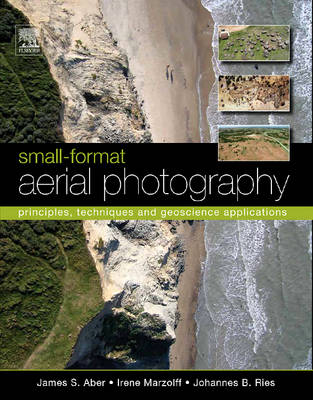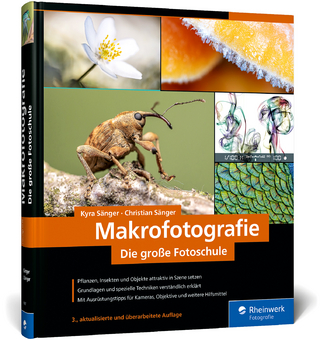
Small-Format Aerial Photography
Elsevier Science Ltd (Verlag)
978-0-444-53260-2 (ISBN)
- Titel erscheint in neuer Auflage
- Artikel merken
As the need for geographical data rapidly expands in the 21st century, so too do applications of small-format aerial photography for a wide range of scientific, commercial and governmental purposes. Small-format Aerial Photography (SFAP) presents basic and advanced principles and techniques with an emphasis on digital cameras. Unmanned platforms are described in considerable detail, including kites, helium and hot-air blimps, model airplanes, and paragliders. Several case studies, primarily drawn from the geosciences, are presented to demonstrate how SFAP is actually used in various applications. Many of these integrate SFAP with ground-based investigations as well as conventional large-format aerial photography, satellite imagery, and other kinds of geographic information.
Dr. Aber has a PhD in Geology from the University of Kansas. His interests and research experience are wide ranging in geology, tectonics, landscape evolution, wetland environments, remote sensing, aerial photography, and energy resources. He has conducted field investigations across the United States as well as Canada, Scandinavia, Central Europe and Japan. He is a distinguished professor at Emporia State University, Kansas. Dr. Marzoff is a physical geographer and remote sensing/GIS scientist holding a Ph.D. from Freiburg University, Germany. She has been working on high-resolution remote sensing methods for monitoring land degradation and erosion since 1995. She has been involved in designing and building several unmanned platforms for small-format aerial photography and has developed remote-sensing and photogrammetry-based methods for quantifying geomorphological processes in high temporal and spatial resolution. She has collaborated in numerous research projects with colleagues from Belgium, Germany, India, Morocco, Spain and the USA Dr. Ries holds a Ph.D. from Freiburg University, Germany. His research focusses on methodological questions regarding erosion, land degradation and desertification. His main expertise lies in experimental geomorphology, and small-format aerial and terrestrial photography has always been an integral part of his research concepts and projects. He has extensive international research cooperation and during recent years has conducted fieldwork mostly in semi-arid regions of Europe and Africa
Part I
Chapter 1: Introduction to small-format aerial photography
1-1. Overview
1-2. Brief history
1-2.1. 19th century
1-2.2. 20th century
1-3. Photography and imagery
1-4. Conventional aerial photography
1-5. Small-format aerial photography
1-6. Summary
Chapter 2: Basic principles of SFAP
2-1. Remote sensing
2-1.1. Ideal remote sensing
2-1.2. Actual SFAP
2-2. Common aspects of SFAP
2-2.1. Image vantage
2-2.2. Photographic scale and resolution
2-2.3. Relief displacement
2-2.4. Stereoscopic images
2-3. Photographic storage
2-4. Summary
Chapter 3: Photogrammetry
3-1. Introduction
3-2. Geometry of single photographs
3-2.1. Vertical photography
3-2.2. Tilted photography
3-2.3. Interior orientation
3-2.4. Exterior orientation
3-3. Geometry of stereophotographs
3-3.1. Principle of stereoscopic viewing
3-3.2. Base-height ratio and stereoscopic coverage
3-3.3. 3D measurements from stereomodels
3-3.4. Creating stereomodels with aerial triangulation by bundle-block adjustment
3-4. Quantitative analysis of photographs
3-4.1. Measuring and mapping from single photographs
3-4.2. Manual measuring and mapping from stereomodels
3-4.3. Automatic DEM extraction from stereomodels
3-5. Summary
Chapter 4: Lighting and atmospheric conditions
4-1. Introduction
4-2. Multiview-angle effects
4-3. Bidirectional reflectance distribution function
4-4. Multispectral effects
4-5. Latitude and seasonal conditions
4-6. Clouds
4-7. Shadows
4-8. Summary
Chapter 5: Photographic composition
5-1. Introduction
5-2. Basic elements of photographic composition
5-2.1. Oblique and vertical views
5-2.2. Linear features
5-2.3. Image depth
5-2.4. Pattern and texture
5-2.5. Color
5-3. Combining compositional elements
5-4. Photographs vs. human vision
5.5. Summary
Part II
Chapter 6: Cameras for SFAP
6-1. Introduction
6-2. Film camera basics
6-3. Digital camera basics
6-3.1. Types of digital cameras
6-3.2. Image sensors
6-3.3. Image file formats
6-4. Camera geometry and light
6-4.1. Focal length
6-4.2. Lens aperture
6-4.3. Shutter speed
6-4.4. Film speed or ISO rating
6-4.5. Camera exposure settings
6-4.6. Image degradation
6-5. Color-infrared photography
6-6. Camera capabilities for SFAP
6-6.1. Camera lens
6-6.2. Image sensor
6-6.3. File format
6-6.4. Camera type
6-6.5. Camera calibration
6-7. Summary
Chapter 7: Camera mounting systems
7-1. Introduction
7-2. Camera operation
7-3. Detachable mounts
7-3.1. Single-camera suspended rigs
7-3.2. Multiple-camera suspended rigs
7-3.3. Attaching suspendable mounts to a platform
7-3.4. Detactable modular unit mounts
7-4. Fixed mounts
7-5. Summary
Chapter 8: Platforms for SFAP
8-1. Introduction
8-2. Manned light-sport aircraft
8-2.1. Powered light-sport aircraft
8-2.2. Unpowered light-sport aircraft
8-3. Lighter-than-air platforms
8-3.1. Lifting gases
8-3.2. Helium blimp
8-3.3. Hot-air blimp
8-4. Kite aerial photography
8-4.1. Kites for SFAP
8-4.2. Kite-flying equipment
8-4.3. Ground operations
8-5. Drones for SFAP
8-5.1. Basic model airplane
8-5.2. Autopiloted model airplane
8-5.3. Powered paraglider
8-6. Pros and cons of different platforms
8-7. Summary
Chapter 9: SFAP survey planning and implementation
9-1. Introduction
9-2. Travel and equipment logistics
9-3. Site accessibility and characteristics
9-3.1. Local site accessibility
9-3.2. Flight obstacles
9-3.3. Local wind conditions
9-3.4. High-altitude SFAP
9-4. Ground Control
9-4.1. GCP installation
9-4.2. GCP coordinate measurement
9-5. Flight planning considerations
9-5.1. Image scale and resolution
9-5.2. Stereoscopic and large-area coverage
9-6. Flight planning example
9-6.1. Initial calculations: Complete coverage with single image
9-6.2. Revised calulations: Optimal image resolution
9-6.3. Consequences for aerial survey design
9-6.4. Ideal flightline calculation
9-7. Flight planning for oblique SFAP
9-8. Legal issues
9-8.1. German regulations
9-8.2. Regulations in the U.S. and other countries
9-8.3. Insurance
9-9. Summary
Chapter 10. Image interpretation
10-1. Introduction
10-2. Image interpretability
10-3. SFAP interpretation
10-3.1. Water and drainage
10-3.2. Geomorphology
10-3.3. Vegetation and agriculture
10-3.4. Cultural heritage and archaeology
10-3.5. Soils
10-4. Summary
Chapter 11: Image processing and analysis
11-1. Introduction
11-2. Geometric correction and georeferencing
11-2.1. Reference coordinate systems
11-2.2. Image rectification
11-2.3. Image mosaics
11-3. Image enhancement
11-3.1. Correcting lens-dependent aberrations
11-3.2. Contrast enhancement
11-3.3. Image filtering
11-4. Image transformation
11-4.1. Image ratios and vegetation indices
11-4.2. Principal components analysis and color-space transformations
11-5. Image classification
11-6. Stereoviewing and photogrammetric analysis
11-6.1. Creating simple on-screen stereoviews
11-6.2. Using printouts under a stereoscope
11-6.3. Digital stereoviewing
11-6.4. Stereoscopic measuring and mapping
11-6.5. DEM generation
11-7. Software for SFAP analysis
11-8. Summary
Part III
Chapter 12: Glacial geomorphology
12-1. Introduction
12-2. Glacial erosion
12-3. Glacial deposition
12-4. Glacial deformation
12-5. Summary
Chapter 13: Gully erosion monitoring
13-1. Introduction
13-2. Study sites and survey
13-3. Gully mapping and change analysis
13-4. Summary
Chapter 14: Wetland environments
14-1. Overview
14-2. Raised bogs, Estonia
14-2.1. Endla Nature Reserve
14-2.2. Nigula Nature Reserve
14-2.3. Discussion
14-3. Prairie marshes and playas, Kansas
14-3.1. Cheyenne Bottoms
14-3.2. Dry Lake
14-3.3. Discussion
14-4. Summary
Chapter 15: Biocontrol of salt cedar
15-1. Salt cedar problem
15-2. USBR study site
15-3. Analysis of KAP results
15-4. Summary
Chapter 16: Vegetation and erosion
16-1. Introduction
16-2. Monitoring vegetation and erosion test sites
16-3. Influence of grazing on vegetation cover
16-4. Combating desertification and soil degradation
16-5. Summary
Chapter 17: Soil mapping and soil degradation
17-1. Introduction
17-2. Soils and long-term human land use
17-3. Summary
Chapter 18: Architecture and property management
18-1. Introduction
18-2. Nelson-Atkins Museum of Art, Kansas City, Missouri
18-3. Property management, Lake Kahola, Kansas
18-4. Summary
Chapter 19: Golf course management
19-1. Overview
19-2. Garden City, Kansas
19-3. Summary
References
Index
| Erscheint lt. Verlag | 28.5.2010 |
|---|---|
| Verlagsort | Oxford |
| Sprache | englisch |
| Maße | 216 x 276 mm |
| Gewicht | 1250 g |
| Themenwelt | Kunst / Musik / Theater ► Fotokunst |
| Sachbuch/Ratgeber ► Freizeit / Hobby ► Fotografieren / Filmen | |
| Naturwissenschaften ► Geowissenschaften ► Geografie / Kartografie | |
| Technik | |
| ISBN-10 | 0-444-53260-9 / 0444532609 |
| ISBN-13 | 978-0-444-53260-2 / 9780444532602 |
| Zustand | Neuware |
| Haben Sie eine Frage zum Produkt? |
aus dem Bereich


